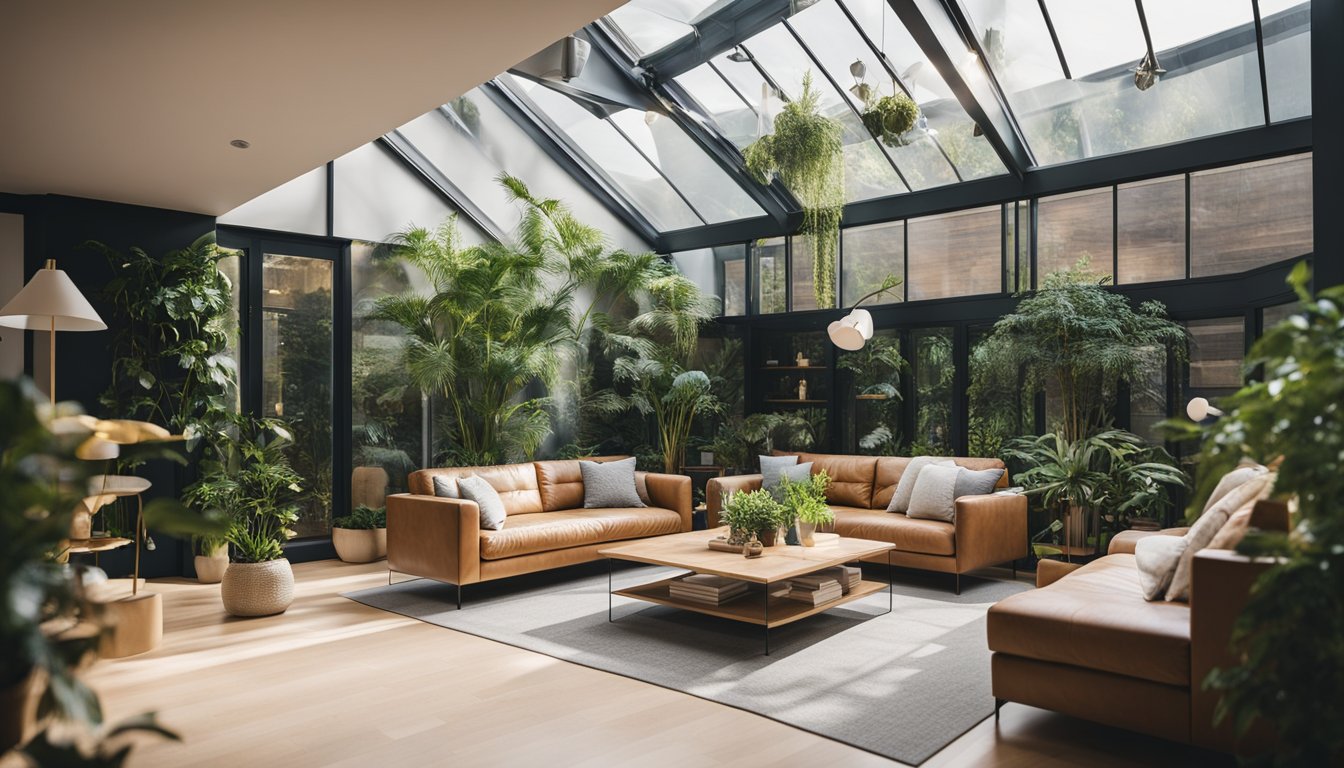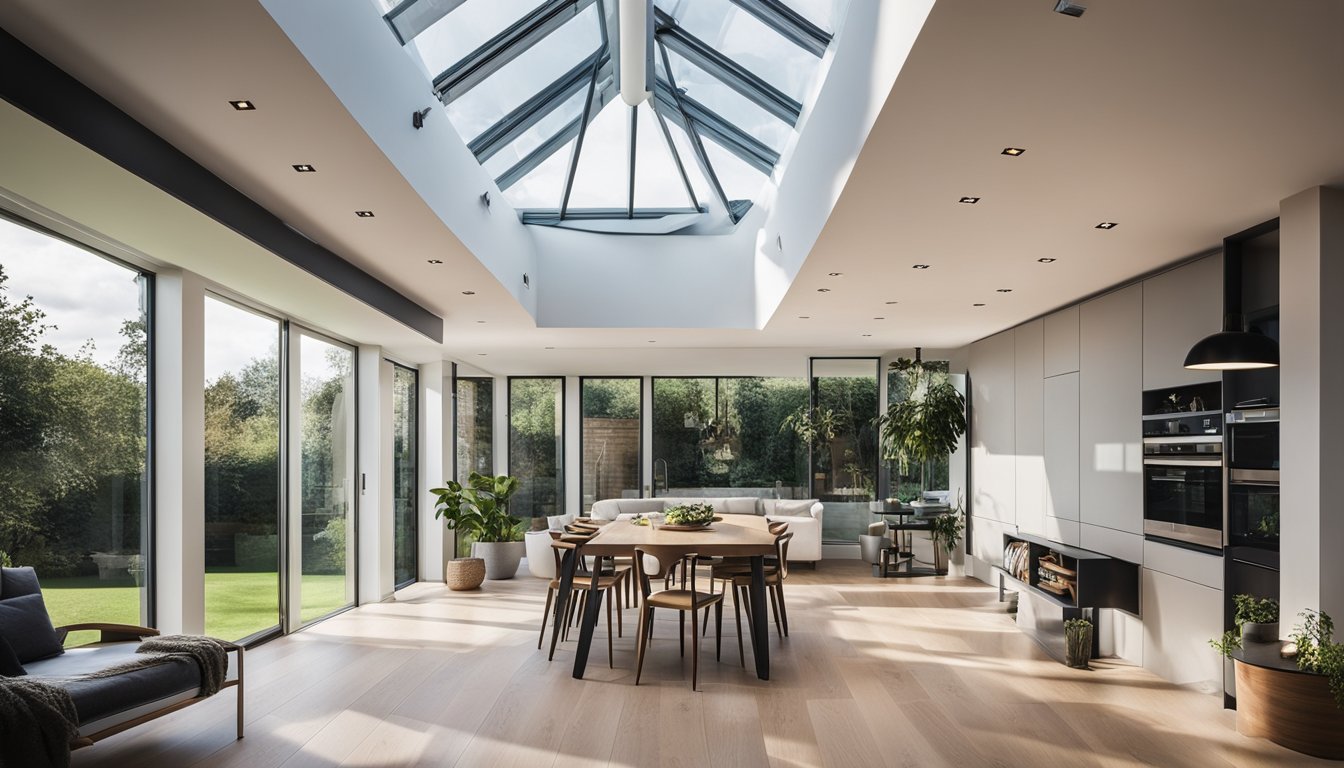Late updated: 20 Aug 2024 15:08
Written by: Oliver Bennett
Innovative Skylight Ideas For UK Homes: Enhancing Natural Light and Aesthetics
Innovative skylight designs have the power to transform UK homes by introducing an abundance of natural light and adding a modern touch to any architectural style. Installing a well-designed skylight can significantly enhance the ambience of your living space, making it feel open, airy, and welcoming. From pyramid-shaped glass skylights to whimsical sciography effects, there are myriad options that not only illuminate your interiors but also create unique aesthetic features.

In our exploration of skylight ideas, we find astonishing versatility. Whether you own a period-style property or a contemporary home, there's an innovative skylight design to suit your needs. Pyramid-shaped glass skylights, for example, bring a visually striking architectural element, while other designs can create breathtaking light patterns on walls and floors, adding a dynamic dimension to your home.
Integrating skylights also comes with practical benefits, such as energy savings and improved ventilation. Skylights allow more natural light to penetrate your home, reducing the need for artificial lighting during the day. Moreover, strategically placed skylights can enhance airflow, contributing to a more comfortable and healthier living environment.
Key Takeaways
- Skylights enhance natural light and modernise home aesthetics.
- Various designs suit period-style and contemporary homes.
- Practical benefits include energy savings and improved ventilation.
Designing Skylights for Modern UK Homes
As we explore skylight options for UK homes, it's crucial to consider the types, materials, and technological aspects that make them both functional and aesthetically pleasing.
Types of Skylights and Rooflights
When selecting skylights, we have numerous options to choose from. Roof windows, rooflights, and roof lanterns all serve different purposes.
Roof windows are usually installed within a pitched roof and offer easily accessible, operable options. Rooflights are often non-opening and installed in flat or gently sloping roofs. Roof lanterns act as architectural features, creating a dramatic effect with their raised, multi-pane design.
For those looking to maximise natural light, a light well can draw light from the rooftop down to lower floors.
Material Considerations for Durability and Style
Material selection directly influences both the durability and style of skylights. Common materials include wood and aluminium.
Wooden frames provide a traditional aesthetic and can be treated for enhanced durability. They imbue the interior with warmth and can be painted or stained to match decor.
Aluminium frames are popular for modern and contemporary styles. They are sleek, lightweight, and require minimal maintenance. Aluminium frames also offer superior weather resistance, essential for the UK's varied climate.
Choosing the right material depends on the desired look and the maintenance capabilities of the homeowner.
Technological Integration in Skylight Features
Modern skylights come equipped with a range of technological features that enhance usability and energy efficiency.
Automated systems allow for remote operation of skylights, incorporating sensors that close windows automatically when it starts to rain. Many models now integrate with smart home systems, enabling control via smartphone apps.
Energy-efficient glazing options, such as low-E glass, minimise heat loss and reduce energy bills. Some skylights feature built-in blinds or shades that can be adjusted electronically to control light and temperature.
Moreover, skylights can incorporate ventilation options, providing fresh air circulation which is particularly beneficial in areas prone to dampness like bathrooms and kitchens.
Benefits and Practical Aspects of Installing Skylights

When we think about skylights, their benefits extend beyond aesthetic appeal, encompassing factors like improved air quality, energy efficiency, and sustainable living. Understanding the practical aspects is essential to make the most of these features in our homes.
Enhancing Home Ambience and Interior Design
Skylights bring natural daylight into our homes, enhancing the ambience and creating spaces that feel open and welcoming. In living rooms, bedrooms, or bathrooms, well-placed skylights can transform the interior, offering a unique architectural element. Using multiple skylights can distribute light more evenly, reducing the need for artificial lighting and highlighting interior design features.
Moreover, the right skylight designs can elevate the aesthetic appeal of a space. Choices range from traditional models to modern, sleek designs. For those who enjoy stargazing, certain skylights offer clear night-time views, adding another layer of enjoyment. In *period-style homes*, the combination of historic elements with modern skylights can create a striking visual contrast.
Considerations for Light and Privacy
A primary concern when installing skylights is managing light and ensuring privacy. Optimal placement is crucial to avoid excessive sunlight that could cause glare or overheating. We must carefully consider the rooms' orientations and the size of skylights to control the amount of light entering different areas throughout the day.
For increased privacy, especially in bedrooms and bathrooms, skylights can be fitted with remote-controlled blinds or frosted glass. This allows us to balance natural light with the need for discretion. Options like sun tunnels can be effective in spaces requiring light without direct visibility, providing innovative solutions to light darker corners without compromising privacy.
Energy Considerations and Cost Efficiency
Skylights play a significant role in improving our home's energy efficiency. By maximising the use of natural daylight, we can reduce our reliance on artificial lighting, cutting down on electricity costs. Additionally, ventilating skylights help improve air quality by allowing hot air to escape, thus reducing the need for air conditioning during the warmer months.
Despite initial installation costs, competitively priced skylights can offer long-term savings through reduced energy costs and enhanced sustainability. By selecting energy-efficient models with good insulation and rain sensors, we ensure that our homes remain comfortable year-round. These features not only make skylights a smart investment but also contribute to a more sustainable lifestyle.
Frequently Asked Questions

We often receive questions about integrating skylights into UK homes, their impact on energy efficiency, and the regulations governing their installation. Below, we address some of the most common inquiries.
What factors should be considered when integrating a skylight into an existing UK home structure?
When integrating a skylight, it's essential to consider the orientation of the house, the roof's pitch, and the type of room it will be installed in. Material choices and weatherproofing methods are also critical to avoid leaks.
How does a skylight impact the energy efficiency of a home in the UK?
Skylights can significantly boost energy efficiency by reducing the need for artificial lighting and improving ventilation. However, choosing energy-efficient glazing and proper insulation around the skylight is crucial to prevent heat loss during winter.
Can skylights be designed to fit bespoke or non-standard UK house roof dimensions?
Yes, many manufacturers offer custom skylights designed to fit unique or irregular roof spaces. Bespoke solutions ensure that even homes with unconventional roof designs can benefit from natural light without compromising on design or fit.
What are the safety standards and regulations governing the installation of skylights in UK homes?
In the UK, skylight installations must comply with Building Regulations, which cover aspects like thermal insulation, structural integrity, and fire safety. We recommend consulting with a professional installer familiar with these regulations to ensure compliance.
How do modern skylight materials and technologies enhance natural lighting in UK homes?
Modern skylights use advanced glazing technology to maximize natural light while minimizing UV exposure and heat gain. Innovations like self-cleaning glass and solar-powered blinds further enhance functionality and convenience.
What are the options for shading or covering skylights in UK homes to control light and heat?
Several options are available for shading skylights, including manual and electric blinds, shades, and film coatings. These solutions allow homeowners to control light levels and heat gain, improving comfort throughout the year.
